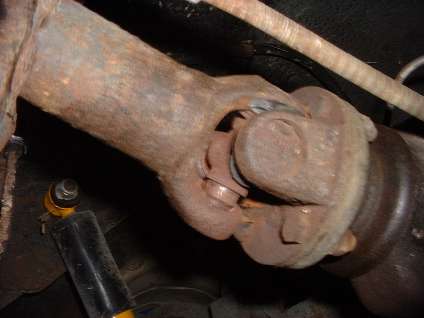The MGA With An Attitude
THE BAD U-JOINT - or when to be SCARED -- PS-102
NOTICE: An attentive driver might identify a bad universal joint in the propshaft by the vibration it creates in the car when driving at highway speed. It may vibrate more under light throttle, and vibrate less (maybe) when you take your foot off the go pedal. A bad front U-joint may cause the shift lever to vibrate in your hand. A bad rear U-joint may vibrate the chassis of the car a bit with little or no noticeable vibration at the shift lever. But when the problem is bad enough to be noticeable while driving, this is indication that the maintenance has been neglected. The worn u-joint should be detected much sooner by inspection during regular periodic maintenance of the vehicle.

Do NOT let this happen to you.
At 10:05 PM 4/2/04 -0500, Chuck Jackson wrote:
>"While I was under the car, and with the brakes locked, I rotated the drive shaft back and forth. I can in fact do that (slightly)."
So where is the motion, at the input to the differential, or in the rear u-joint?
>" .... there is a clicking noise in the area of the differential when I do so (maybe it is in the U Joint itself?)".
Maybe ???
"There appears to be about a 1/32 inch play in the U joint between the two sections of the drive shaft as I rotate it. Is that normal?"
HELL NO !!! There should be absolutely no free rotation (backlash) at all in a u-joint. When they they look like the picture above they are life threatening, .... and it vibrates with a vengence at speed. Shortly thereafter the propshaft falls off in the street while you're driving, and if you're lucky, maybe nobody gets killed.
When you find a loose U-joint you should replace it immediately. Once a u-joint is worn to the point of having noticeable (detectable) freeplay, all the grease in the world isn't going to help it much. With sloppy internal parts the U-joint will proceed to self destruct with additional driving. From the time it has only a miniscule amount of detectable freeplay to the time when you can feel a noticeable vibration at highway speed (slight latteral freeplay) might be a few thousand miles (which is why it should be detected during normal maintenance).
However, from the time when you can first feel a noticeable vibration at highway speed to the time of immenent drive failure (like in the picture) may be as little as a few hundred miles. So if you're on a long road trip when it happens, figure on stopping at the next town to pick up a new U-joint. If you are compelled to drive any significant distance with the loose U-joint, then at least take it easy and pull over occasionally to crawl under the car to check on it. When it gets as bad as the picture above, then the mating yokes of the propshaft WILL be damaged. The flanged yoke is replaceable, but if the yoke which is permanently attached to the tube is damaged, then you have to replace the whole thing. So it is MUCH cheaper to fix it early when it only needs the spider part.
This is a common part used in many different models of cars for many decades. If it is not in stock at the first parts store you come to, they should be able to get it delivered from a local source immediately. The same U-joint was used for MGs at least as far back as the TC in 1945 (and probably earlier cars as well), and continued in MGs until the MGB went out of production in 1980. So if you're driving one of the older MGs, and the parts store doesn't have a listing for it, just tell them it's for a 1980 MGB.
Instructions for installing the new U-joint are in the workshop manual. I won't say it's really easy, but it's not a great mystery either. It is much easier to do in your garage with a work bench and proper tools than when sitting on a curb with loose parts on the ground. If you have done it once before, you may be able to figure out how to do it in a parking lot. Otherwise I would advise you to nurse it home (if it's not too far) or find a friendly service garage as soon as possible. This little chore requires some finesse, so having ten thumbs is a distinct disadvantage.

Late MGA propshaft front yoke
Along similar lines, the later model MGA cars have the double flanged propshaft with the sliding spline joint aft of the front U-joint. When these are neglected (not greased often enough) the splines can wear out. If there is any latteral freeplay in this joint you may notice the same vibration that is caused by a loose U-joint. While this problem is not immediately hazzardous, continued vibration of the propshaft can eventually destroy the U-joint, or a gearbox rear seal, or even the tail bearing in the gearbox. So again it is prudent to repair this as soon as possible.
The splined yoke as shown in the picture above is replaceable, and a new one might fix the problem (maybe). But if the male splines are worn significantly, then the main tube of the propshaft will also have to be replaced. Considering the price of these parts, you might consider procuring a used propshaft with serviceable splines, and replacing U-joints if necesary.
|

